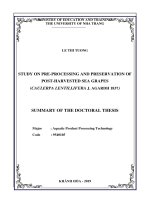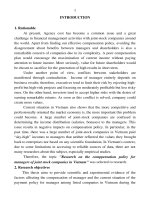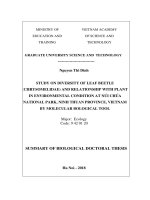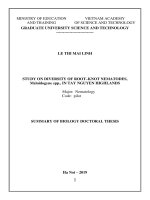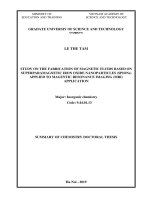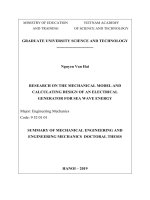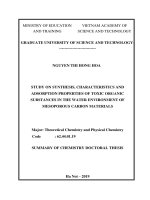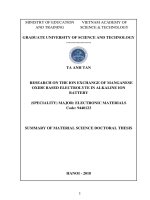Summary of biological doctoral thesis: Study on the diversity of leaf beetle (Chrysomelidae) and relationship with plant in environmental condition at Nui Chua national park, Ninh Thuan
Bạn đang xem bản rút gọn của tài liệu. Xem và tải ngay bản đầy đủ của tài liệu tại đây (888.1 KB, 25 trang )
MINISTRY OF
VIETNAM ACADEMY
EDUCATION AND
OF SCIENCE AND
TRAINING
TECHNOLOGY
GRADUATE UNIVERSITY SCIENCE AND TECHNOLOGY
---------------------------Nguyen Thi Dinh
STUDY ON DIVERSITY OF LEAF BEETLE
(CHRYSOMELIDAE) AND RELATIONSHIP WITH PLANT
IN ENVIRONMENTAL CONDITION AT NÚI CHÚA
NATIONAL PARK, NINH THUAN PROVINCE, VIETNAM
BY MOLECULAR BOLOGICAL TOOL
Major: Ecology
Code: 9 42 01 20
SUMMARY OF BIOLOGICAL DOCTORAL THESIS
Ha Noi - 2018
This dissertation was completed at Graduate University Science
and Technology – Vietnam Academy of Science and Technology
The first supervisor : Asso. Prof. Dr. Nguyen Van Sinh
The second supervisor: Dr. Jesús Gómez-Zurita
The first reviewer: …
The second reviewer: …
The thirt reviewer: ….
This dissertation will be defended before the academic evaluation
board of the doctoral thesis, at meeting room in Graduate
University Science and Technology – Vietnam Academy of
Science and Technology, in ...h’, date … 2018….
Please reference in:
- Library of Graduate University Science and Technology
- Vietnam national library
1
INTRODUCTION
1. Reason for choosing the topic
Biomes are interdependent. Plant communities relate to
physical properties of environment as: temperature, humidity, solar
radiation… Those physical properties change with altitude and vary the
structure of plant communities. Plant are food of insects and have an
important role in the diversity and distribution of insects. Study on
responding of herbivore with the change of plant communities in
altitude will help us over the understand about relationship
interdependent each other in the ecosystem.
Chrysomelidae is the biggest family in Coleoptera order. Their
food are plant, therefore Chrysomelidae relates to plant in all their life
and sampling them is easy. For those reasons, Chrysomelidae is a
suitable object to study the interaction of biomes in the ecosystem.
Nui Chua national park includes the area of semi-driest forest
in Vietnam. Plant communities change in altitude from dry forest on
low land through semi-humid forest green humid forest on a high
mountain. For those reasons, Nui Chua national park is the ideal site to
carry out researching.
For above all reason, I choose the topic “ Study on the
diversity of leaf beetle (Chrysomelidae) and relationship with plant
in environmental condition at Nui Chua national park, Ninh Thuan
province, Vietnam by molecular biological tool ”
2. Objects of research
Appraising of the species diversity and the variation according
to space of Chrysomelidae in Nui Chua national park.
2
Determining the food of Chrysomelidae and appraising the change
of their food according to space.
3. The main contents of the dissertation
Using ADN Barcoding to appraise the species diversity of
Chrysomelidae in Nui Chua national park.
Using AND Barcoding to determine the food of Chrysomelidae in
Nui Chua national park.
Determine the component variables of Chrysomelidae and their
food according to space in Nui Chua national park.
1.1.
CHAPTER 1. OVERVIEW
The topic relates to the dissertation
1.1.1. Using the molecular biological tool to measure biodiversity
1.1.1.1. Biodiversity and problems related
Definement biodiversity: Biodiversity is the diversity in three levels:
gene, species and ecosystem. In there, the diversity of species is used
in studying biology, conservation and ecology. Mora et al. (2011)
predicted that there are about 8,7 million (± 1,3 million) of eukaryote
on the earth; among there, about 2,2 million (± 0,18 million) live under
the ocean. And they think that about 86% of living species on the land
and 91% of living species under ocean are waiting for describing. So
far, total known species in the world are approximately 1.900.000
species and every year there are 18.000 new species to be described
(Chapman 2009). In there, tropical forest supports 50% of biodiversity
on the earth (Myers 1988, Mittermeier et al. 1998) and 80% of known
insect species (WWF), 1998) although the tropical forest only covers
<10% of areas of the earth (Achard et al. 2002).
3
Measuring Biodiversity: Biologist usually measures the biodiversity
by measuring species richness. There are two main methods to
measure species richness, that are quality (the number of species) and
quantity (the number of individual or living mass per unit of area)
method. The best method for measuring biodiversity is to measure the
abundance of all organism following space and time, using a
classification (the number of species), function and interactions
between species. Or measuring a changing of biodiversity in space and
time. But, today we could not to exactly do this highly because of the
lack of data.
Crisis of biodiversity: is lost of gene, species and ecosystem. Vos et
al. (2015) estimated that the lost in nature about with ratio 0,1 species
per million species per year and now aday, the ratio of extinct is higher
1000 times when compare with natural extinct and in the future could
be higher 10.000 times. Levin (2002) shown that average of 20
minutes there is one species be lost.
Impediment of classification in studying biodiversity: The lack of
name and difficulty to recognize species in ecological research is
impediment of classification (New, 1984). This influence on
conservational research. Because of there are many species to be
extinct before described and we will not know how many species are
on the earth. This impediment makes us misunderstand about
biodiversity on the earth.
1.1.1.2. Using molecular biological tools to measure rapid biodiversity
Using molecular biological tool to measure the diversity of species:
ADN barcode in Mitochromosome (COI gene) is the useful tool to
determine animal species.
ADN barcode is a good tool for
4
determining known tspecies and detecting new species (Hebert et al.
2003, 2010, Savolainen et al. 2005). ADN barcode support data for
classification more exactly (Thompson et al. 2012). ADN barcode
help determining species in the case species only recognized in family
or genus level.
In the plant, the ADN in chromosome are used for determining
species. Gene rbcLa and matK are barcode for plant land (CBOL Plant
Working Group 2009). Add this, two sites trnH-psbA and nrITS are
puted forward as supplemental ADN barcode for plant (Hollingsworth
et al. 2011, Li et al. 2011).
Using molecular biological tool to study ecological interaction: By
this method, plant ADN is extracted from the insect's gut. A part of
Chloroplast ADN are amplified, sequences of plant ADN are
compared with Genbank. This method permits us to determine host
plant of hebivove with no observing field.
1.1.2. Heterogeneity of the environment and how it influences
biodiversity.
Haller et al. (2013) said that, there are two space pattern on
the earth: superpopulation pattern in their organism live in a two or
many fragmentary and environmental gradient pattern. The
heterogeneity of environment by two factors: the first because of the
change of environment and continuously because of fragment in
space. They conclude that the heterogeneity of environment was
created regime of choices differently motivate diversity that is an
important motive for species formation.
5
1.1.3. Chrysomelidae is suitable object to apply the
molecular biological tool to measure biodiversity and study
interaction in the ecosystem.
Chrysomelidae is a big family in Coleoptera order.
Chrysomelidae is great diversity (the number species and their host
plant) and easy to collect… Therefore Chrysomelidae is suitable
object to apply the molecular biological tool to study their diversity
and interaction between Chrysomelidae and their host plant (Price
2002).
1.1.3.1. Overview about studying Chrysomelidae in Vietnam.
Chrysomelidae in Vietnam was studied about classification,
biology, ecology… from 1975 to 2008. Specially in North of Vietnam
(Tam Đảo, Hòa Bình, Hà Nam, Ninh Bình..), and midle of Vietnam
(Quảng Bình, Quảng Trị and Thừa Thiên Huế) and Highland of
Vietnam (Đặng Thị Đáp & Medvedev, 1982- 1989; Đặng Thị Đáp et
al. 2005-2008). Classification of Chrysomelidae in Vietnam is studied
by many foreign scientists as Medvedev (1983- 2015), Kimoto (1997,
1998, 2000). There are about 700 species of Chrysomelidae are
recorded and published in Vietnam. Predicting the number of species
Chrysomelidae can be over 1000 species. This show that
Chrysomelidae in Vietnam are great diversity and many species are
waiting to describe new for science. But information about host plant
of Chrysomelidae in Vietnam are limited. Đặng Thị Đáp (1983)
studied about the influence of landscape to distribution of Cassidinae
subfamily, but haven’t researched about responding of Chrysomelidae
with environmental gradient yet. 2005 year, Tạ Huy Thịnh et al.
6
Studied about insects in Nui Chua national park, but he did not study
about Chrysomelidae community. .
1.1.3.2. Overview about studying Chrysomelidae on the world.
Chrysomelidae on the world were deeply studied about host
plant (Jolivet và
Hawkeswood 1995), biology, classification,
evolution, ecology…. (Jolivet, và Cox , 1996). Now aday, scientist
used molecular biological tool to study phylogeny of Chrysomelidae
(Montelongo và Gómez-Zurita, 2014; …), measuring their diversity
of Chrysomelidae (Thormann et al., 2016) and seek their host plant
(De la Cadena et al. 2016; Kishimoto-Yamada et al. 2013; JuradoRivera et al.2009…). There are research about the change of species
by altitude, almost research are in South and Central America and on
coleoptera and butterfly (24,5%), only have several research on
Chrysomelidae.
1.2.
Research site
1.2.1. Locality
Research was carried out in the Núi Chúa National Park, Ninh
Thuan province, South of Vietnam. The Núi Chúa national park was
located from 11°35'25" to 11°48'38" of North latitude and from
109°4'5" to 109°14'15" of East longitude. Núi Chúa includes 29.865
ha, in there the land are 22.513 ha and the ocean is 7.352 ha, and the
buffer zone is 7.350 ha in area
1.2.2. Terrain
The shape of Núi Chúa national park as Tortoise with a head in
South, tail in Xốp peak. Núi Chúa includes many peaks, the highest
peak is Cô Tuy mountain where is 1039m in high.
7
1.2.3. Climate and hydrography
Climate in Núi Chúa national park is dry, rain season is later
and end earlier than the other area in Vietnam, starting from
September in October and ending in December.
1.2.4. Plant ecology
Ecosystem in Núi Chúa national park is a semi-dry plant in
low mountain and evergreen plant in high mountain.
1.2.5. Fauna and flora
Flora in Núi Chúa national park have recorded
1.504
vascular plant species belong to 85 orders, 147 families, 596 genera in
7 phyla Fauna in Núi Chúa national park have recorded 330 vertebrate
species, in there 84 animal species, 163 bird species and 83
amphibians – reptiles species, 46 species in there are in Vietnam red
books. In research 2004 year, Tạ Huy Thịnh et al., have recorded 10
orders, 95 families and 361 insect species in Núi Chúa.
Summary, the Núi Chúa national park is unique and driest
forest in Việt Nam and plant communities change with altitude from
dry forest on the lowland, through semi-humid to humid evergreen
forest on a high mountain, therefore Núi Chúa is the ideal site to carry
out this research.
Chapter 2: RESEARCH METHOD
2.1. Sampling and delimitation biomes in Núi Chúa national
park.
2.1.1.
Sampling
8
Specimens were collected 10 times in two years (2012 and
2013 years) fixed and along 5 paths in the Núi Chúa national park:
Mái Nhà, Đá Đỏ, Ao Hồ, Núi Ông và Suối Trục. In every path,
sampling from the altitude at sea level (corresponding to the dry
ecoregion) go to up at 449m in altitude (corresponding to the transition
ecoregion and a part of the humid ecoregion) and the Ðá Hang path
was only collected one time in the first fieldworking (5/2012) (Figure
2.2). Chrysomelidae are collected by beating around fixed sites along
the paths in each sampling. Beating is carried out during 10 minutes
from shrub, low trees up to high trees until it is impossible to stop
(about 2,5 m). The collected beetles were immediately stored in vials
containing absolute ethanol (96%) for preservation of DNA, vials
labeled for geographical location and sampling path.
Figure 2.2: The sampling map of Chrysomelidae in Núi Chúa national
park (a) The site of the Núi Chúa national park in Việt Nam map (b)
Outline the shape of the Núi Chúa national park and sampling paths (c)
Sampling sites in sampling paths with grey area are assumed transitional
area.
2.1.2. Delimitation biomes in Núi Chúa national park.
Delimitation biomes in the Núi Chúa national park are based
on previous studies of Núi Chúa, combining with analyzing some
9
parameters of the Chrysomelidae population as Sorensen – Dice index
by using the sliding window method (Barton et al. 2013).
2.2.
Molecular biological method
ADN of all specimens of Chrysomelidae collecting in the Núi
Chúa national park are extracted by
DNeasy Blood and Tissue
(Qiagen Iberia) kit by laboratory protocol. We used whole specimens,
which were recovered after DNA extraction, mounted dry and labelled
with a voucher number for the future. We amplified cytochrome c
oxidase 1 (cox1) gene to delimit Chrysomelidae and amplified locus
cpDNA PsbA-TrnH to determine host plant of Chrysomelidae.
2.3.
Method for delimitation Chrysomelidae species
Delimitation Chrysomelidae species by molecular data: We
used phylogenetic methods: Generalized Mixed Yule-Coalescent
(GMYC) pattern with single and multi threshold (Pons J. et al. 2006)
and và sự Poisson Tree Processes (bPTP) pattern (Zhangj-J et al.
2013). We used some softwares as r8s, PADTHd8, BEAST 1.8.1 to
get ultrametric tree. Using "splits " package (Ezard et al. 2009) in R
3.1.1 software to delimit by GMYC pattern with single and multi
threshold. bPTP pattern is ran online on the web "bPTP server"
().
Classification species by morphology.
Specimens are
classified by key of Kimoto (2000, 1989, 1982, 1981). The result is
compared with result of molecular biological methods.
2.4. Method determination host plant of Chrysomelidae in Núi
Chúa national park: Using BAGpipe program.
10
2.5.
Estimate expected species richness of Chrysomelidae in
Núi Chúa national park. Using EstimateS 9.1 software.
2.6.
Method research interaction between Chrysomelidae and
environment.
2.6.1. Analyzing the change of Chrysomelidae with spaces: Using
EstimateS 9.1 software (Colwell 2013) to calculate Jacard and
Sorensen indexes. Measuring dissimilarity by “betapart” package R.
2.6.2. Canonical Correspondence Analysis (CCA) to detect factor
imfluent on interaction between Chrysomelidae and their host
plant: Using “vegan” 2.0-10 package in R.
2.6.3.
Mesruring
Beta
diversity
of
interaction
between
Chrysomelidae and their host plant by biome (altitude): Using
“BAT” and “betalink” 2.1.0 packages in R software.
2.6.4. Analysing topology of interaction between Chrysomelidae and
their host plant. Using “Bipartite” 2.05 package in R software.
Chapter 3: RESULTS OF RESEARCH
3.1. Delimitation of biomes
We recommend elevational intervals from 160 m to 320 m as
a transition zone between dry biome and moist biome in the sampling
area. The midpoint (300 m) is considered as the strong boundary of
the transition area for further analysis of the Chrysomelidae
community and their host plant according to elevation.
3.2. Species diversity of Chrysomelidae in Núi Chúa national park.
3.2.1. Species diversity of Chrysomelidae of Chrysomelidae in Núi
Chúa national park basing on morphology
Total 520 specimens of Chrysomelidae collected in the Núi
Chúa national park. Using classificatinal keys of some authors, we
identified all specimens are in 141 morphospecies. Almost specimens
11
are identified at the genus level, some specimens are to family level,
a few specimens are at species level. In specimens are identified to
species, there are 13 new species for science, 11 species in there
belong to Monolepta Chevrolat genus: M. decreta, M. demimuta, M.
densopunctata, M. dubia, M. fluctuans, M. fuscicorne, M.
interruptomarginata, M. ochracea, M. quotidiana, M. semicostata, M.
thomaswagneri and 2 species belong to Paleosepharia Laboissiere
genus: P. frontis và P. nuichua.
Almost specimens belong to
Eumolpinae, Galerucinae and Alticinae subfamilies. Remaining 7
subfamilies
are
few
specimens,
in
there
two
subfamilies
Cryptocephaninae and Hispinae there are no collected specimens in
some paths. Diversity of species is from 22 species to 58 species in
sampling paths and from 85 species to 95 species in two elevations
(<300m and >300m). (Table 3.1).
Table 3.1: Species diversity of Chrysomelidae in sampling paths
and according to altitude in the Núi Chúa national park (Note:
Morphospecies are above mark “/” and bPTP species“/”)
Subfamily
The
number
of
specimens
The
number
of
species
Paths
ĐĐ
AH
MN
Biomes
NÔ
ĐH
ST
<300m
>300m
Alticinae
49
23/25
4/4
5/5
6/6
8/8
6/7
6/6
17/18
12/12
Bruchinae
7
3/3
-
-
2/2
2/2
-
-
3/3
-
Chlamysinae
3
2/2
-
-
-
1/1
1/1
-
-
2/2
Chrysomelinae
2
2/2
1/1
-
-
-
-
1/1
1/1
1/1
Clytrinae
12
7/7
1/1
-
3/3
-
4/4
3/3
5/5
4/4
Criocerinae
2
2/2
-
-
-
-
2/2
-
-
2/2
Cryptocephalinae
14
9/9
4/4
1/1
1/1
1/1
5/5
1/1
7/7
4/4
Eumolpinae
221
41/51
12/13
7/8
20/22
18/21
19/20
18/19
26/32
30/33
Galerucinae
146
43/45
8/8
6/6
17/17
17/17
19/20
9/9
28/29
28/29
Hispinae
38
9/9
1/1
3/3
8/8
2/2
2/2
1/1
8/8
3/3
Total
494
141/155
31/32
22/23
57/59
49/52
58/61
39/40
95/103
86/90
12
3.2.2. Species diversity of Chrysomelidae in Núi Chúa national park
based on ADN data
The number of species is from 155 species to 186 species
depending delimitational method (Table 3.2). Exception the result of
GYMC pattern with multiple threshold, reminding results match
highly with morphospecies (90 %), only 8 species by bPTP method
are split with single threshold method and two species combined in
one form (Table 3.3). The number of species only has one individual
win 49,7% (bPTP species)
Table 3.2: The result of delimitation species based on ADN of cox1
gên of Chrysomelidae in Núi Chúa national park according to
different algorithm and pattern
Tree
Algor
ithm
Thresh
old
The number
of species
The
number of
clade
Probabiliy
in GMYC
The number
of species
matches
with
morphospeci
es
The
number
of
species
split
with
morpho
species
ML
R8s
single
Multiple
Single
Multiple
Single
Multiple
Single
Multiple
bPTP
178 [175-181]
186 [183-186]
160 [155-163]
161 [152-166]
162 [157-166]
165 [153-165]
164 [158-166]
173 [170-174]
155
63 [62-65]
62 [61-62]
65 [64-66]
76 [73-76]
67 [65-67]
94 [91-96]
66 [66-68]
67 [66-67]
-
500.063
505.887
522.670
527.336
2480.504
2491.387
2463.070
2466.495
-
122
119
124
39
124
39
122
119
126
18
21
16
20
16
21
18
21
14
Pd8
BI
SC
ULN
ML
-
3.2.3. Expected species diversity of Chrysomelidae in Núi Chúa
national park
The result of estimating expected species diversity of
Chrysomelidae shown that the species richness of Ao Hồ, Suối Trục,
The
number
of
species
mix
togethe
r
compar
ing with
morpho
species
0
0
0
81
0
80
0
0
0
13
Đá Đỏ, Mái Nhà and Núi Ông paths are higher from twice (exception
Jack 1 estimator) to 4,3 times (Chao 2 estimator Mái Nhà) (Table: 3.4).
When split data according to altitude, the result shown that the
specimens collected in both biomes hold about 50-75% of expected
species diversity. Estimation for all collected area, the number of
collected species are higher 60% of expected species diversity.
Table 3. 3: The dismatch between morphospecies and bPTP
species of Chrysomelidae in Núi Chúa national park
bPTP
species
023-024
025-026
028-029
030-031
037-039
041-042
046-047
054-055
068-069
095-096
106-107
133-134
139-140
148-149
The number
of
individuals
(1-5)
(1-2)
(1-23)
(1-18)
(2-2-2)
(1-13)
(1-1)
(1-6)
(7-5)
(1-3)
(2-1)
(2-1)
(1-2)
(5-10)
The number
of collected
locality
5
3
18
17
19
12
2
7
12
4
3
3
3
13
The same
path?
The same
biome?
yes
no
yes
yes
yes
yes
no
yes
yes
yes
no
no
no
yes
yes
yes
yes
yes
yes
yes
no
yes
yes
yes
no
yes
no
yes
P- distance of
ADN
0.058±0.005
0.043±0.006
0.125±0.005
0.046±0.004
0.304±0.007
0.228±0.006
0.019±0.005
0.059±0.004
0.070±0.006
0.107±0.007
0.031±0.006
0.071±0.008
0.109±0.011
0.067±0.005
Difference in
morphology
colour
no
no
Size and hair
no
no
no
no
no
no
no
Colour on head
Male genital organ
no
Table 3.4: Expected species diversity of Chrysomelidae in the
paths and research area in the Núi Chúa national park (Using
bPTP species for estimation)
Path
N
The number
of predicted
species to
curve (S)
ICE
Chao2
Jack1
Jack2
AH
DD
DH
MN
NO
ST
<300m
27a
23
40
57a
52
58a
94
48,7±10,09
51,2±11,72
99,9±16,98
120,4±17,61
102,1±15,64
101,8±14,37
147,4±15,18
72
76,48
329,83
170,85
146,52
150,84
201,59
51,47±14,94
96,6±63,16b
173,20±73,69
213,9±86,49b
142,8±46,47b
120,2±28,48b
156,2±22,29
45,0±4,44
39,4±3,63
69,60±5,60
95,3±7,9
86,4±6,33
93,1±6,63
141,2±14,44
56,73
52,61
90,45
126,77
112,53
116,47
167,15
c
14
>300m
74
121,5±13,99
220,64
129,0±20,92
110,07±13,87
126,16
133
197,3±16,31
260,18
250,8±22,44
195,4±13,30
227,80
226,3±17,08
225,3±18,43
301,09
280,94
234,46±22,58
241,8±27,62b
230,00±12,24
227,8±12,40
268,13
271,91
c
Totalc
a
Totald
Totale
155
151
a
a
Some specimens and species can not split to collected sites. b Using classical estimator
(Colwell 2013). c Total samples exception samples from Đá Hang. d Total samples are
separated by collected paths. e Total samples are separated by collected sites. ICE, Chao2,
Jack1, Jack2 are estimator.
3.2.4. Estimation of species richness of Chrysomelidae in Núi
Chúa national park
The result of estimation of species richness is from 225
species to 300 species in explored area. Alpha diversity in the Núi
Chúa national park is high, although specimens are only collected in
the low leaf canopy and no going deep into humid forest.
3.3. Host plant of Chrysomelidae
Using ADN of 146 specimens belong to Galerucinae
subfamily to amplify PsbA-TrnH locus and amplification are
successful for 84 specimens in 32 species. Among there, 12 specimens
got 2 sequences of PsbA-TrnH gene, therefore total 96 sequences of
PsbA-TrnH gene are gotten for 84 specimens. Those 96 sequences
belong to 35 plant orders. The number of host plant of species in
Galerucinae subfamily are from 1 to 10, it depends on the number of
individual of each species. There are 14 species eating on from 2 to 10
plant orders and 18 species only eat on one plant order (those species
only have one individual). The host plant orders of species in
Galerucinae subfamily belong to angiosperm. Total 74 links between
host plants and species in Galerucinae subfamily, so there are 1.1
association/species.
15
3.4. The change of Chrysomelidae population and their food
according to altitude in Núi Chúa national park
3.4.1. Structure of Chrysomelidae through space and elevation in
Núi Chúa national park
3.4.1.1. Influence of “mid-domain” model to Chrysomelidae
population in Núi Chúa national park
The result of research shown that the influence of the mid domain model of Chrysomelidae population is low. The number of
species decrease at elevation > 500m.
3.4.1.2. Variation of Chrysomelidae population, according to space
The ratio of species similarity in pair of collected paths are
from 6,3% to 46,0% (for classical Sørensen index) and from 3,2% to
29,8% (for Jaccard index) (Table 3.5).
The dissimalirity of species in collected paths are by turnover
species component, exception Núi Ông and Suối Trục with
contribution 10% of nestedness species component. Communities
from dry biome (elevation <300m) of each collected path clade
together with the dissimilarities are from 28-34% and mainly by the
turnover species component. In humid biome (at elevation > 300m),
Chrysomelidae communities in Núi Ông và Suối Trục paths are high
similarity and main contribution to the high similarity of those paths.
Chrysomelidae
community
in
transitbiome
is
similar
with
Chrysomelidae community in humid biome. But the turnover species
component in transitbiome is similarity with dry biome than humid
biome (the dissimilarity between transitbiome and dry biome is 48%,
but the dissimilarity between transitbiome and humid biome is 61%),
the nestedness species component is similar between transitbiome and
16
humid biome but the dissimilarity between transitbiome and dry
biome is 14%.
Summary Chrysomelidae community distribute differentce in
the space. The ratio of similarity of Chrysomelidae species between
collected paths and biomes are low (Table 3.5 ), therefore the ratio of
dissimilarity are high (over 0,6) and the dominance of the turnover
species component (ration from 0,68 to 0,77). Beta diversity
contributes to the diversity of all Chrysomelidae communities in the
Núi Chúa national park.
Table 3.5. Comparing the structure of Chrysomelidae
communities between collected paths in the Núi Chúa national
park (Notes: Using classical Sørensen index (below diagonal line)
and Jaccard index (above diagonal line)).
Ao Hồ
Đá Đỏ
Đá Hang
Mái Nhà
Núi Ông
Suối
Trục
Ao
Hồ
0.290
0.138
0.329
0.309
0.322
Đá
Đỏ
0.170
0.063
0.292
0.240
0.238
Đá
Hang
0.074
0.032
0.202
0.195
0.257
Mái
Nhà
0.197
0.171
0.112
0.378
0.366
Núi
Ông
0.183
0.136
0.108
0.233
0.460
Suối
Trục
0.192
0.135
0.147
0.224
0.298
-
In the paths, the all dissimilarities are highest by both splited
space and ecological diversity. Therefore, the paths reach lower
elevation, exception in dry forest and far away (Ao Hồ and Đá Đỏ
paths) contributed for high beta diversity of all Chrysomelidae
communities. When separate samples according to elevation,
community in dry biome group together with the dissimilarity about
0,75. The number of species in low elevation (<300 m) are higher the
17
number of species in high elevation (>300 m), 89 and 74 species,
respectively. The number of species only collects e one individual in
two elevations are similar (38,2% and 35,1%, respectively <300 m and
>300 m).
Reason of different distribution of Chrysomelidae according to space:
We are sure that this is a combination of direct and indirect impact of
the environmental gradient. The indirect impact of environmental
gradient that forms the basis for the structure of plant communities
along the forest type shift is a factor that governs the diversity of
Chrysomelidae in the Nui Chua national park.
3.4.2. The variation of interaction between Chrysomelidae and their
host plant, according to elevation
3.4.2.1. Canonical Correspondence Analysis (CCA)
Using four explanations (biome, species, path and time) and host
plant in order level to analyse CCA. The result of meaningful model
is FCCA=1,452, Chi-sq=2,095, d.f.=4; P=0,001 and shown that the
impact of four explanations to interaction between Chrysomelidae and
their host plant is low (6,93%) and contribution are quite equal by four
axis and four explanations are independent impaction because of VIF
value (factor make increase differently in analysis) are low (1,061,58). But four explanations affect the interaction between
Chrysomelidae and their host plant
(p=0,01-0,045<0,05), among
there biome and paths have more influence than the remain others
because of the chi- square and F values greater than the remain others.
3.4.2.2. Beta diversity of interaction Chrysomelidae and their host
plant, according to altitude in Núi Chúa national park
18
Beta diversity of Chrysomelidae and host plant communities
in the research area is high (>0,7). The dissimilary of networks in two
bimes are high βWN = 0, 92, in there 83,7% by share species (βOS=0,77)
and 16,3% by turnover species (βST=0,15) and the dissimilarity of
component that creates networks is (βS = 0,57).
The result shown that impaction of biomes and paths to
interaction between Chrysomelidae and their host plant. High beta
diversity of Chrysomelidae and host plant communities are reasons for
the dissimilarity of network between Chrysomelidae and their host
plant. High beta diversity of the network is by contribution of share
species in two networks (βO S= 0,77), when turnover species contribute
less than (βST = 0,15). Though, beta diversity of Chrysomelidae anđ
host plant communities is high or share species are low in two
networks (9/32 species for Galerucinae and 8/34 for host plant orders),
but 9 share species are polygophogous (eating many different plants)
which create 43 links with host plant (accounting for 59% of the total
links). Those links mainly contribute for the high dissimilarity of
networks between biomes. The research result is similar with the study
of Novotny (2009). Beta diversity of herbivore defends on specially
about their host plant. The change of host plant change in the space
and the time through different environment make change structure of
herbivore. Novotny et al. (2006) shown that in primary rainforest, the
beta diversity of herbivores is low by the specialty about host plant are
low and high dispersion. Hui Zhu et al. (2015) shown that when there
19
are no cattle, the insect species richness is associated with plant
species richness.
3.4.2.3. Structure of network between Chrysomelidae and their host
plant according to biome (elevation)
Dry biome has 45 links be created by 21 chrysomelidae
species and 25 host plant orders, humid biome has 38 links be created
by 20 Chrysomelidae species and 18 host plant orders. The number of
apartments in humid biome is more than dry biome (respectively 7
and 6), and symmetry of the network in dry habitats<0 but in humid
biome >0. This suggests that Chrysomelidae species in the humid
biome are more food speciality than in dry biome. Due to in dry biome,
with poor food conditions Chrysomelidae species survive having to
eat different plants, in humid biome with abundant food the host plants
provide sufficient food for Chrysomelidae species.
20
3.4.3. Conservatinal activities in the Nui Chua National Park need
to pay attention to the habitat, loss of the Chrysomelidae community
The results from our study with clear relevance to conservation are
that the Chrysomelidae diversity in Nui Chua is very high, and in
particular the high species replacement in the sampling paths at
different elevations and the difference of Chrysomelidae community
is related to plant communities. Consequently, conservation measures
in the Nui Chua National Park should take into account the high
heterogeneity of this diversity. Particularly with the deforestation in
lowland, which has increased rapidly in recent years, the loss of habitat
of Chrysomelidae community will decline the diversity of
Chrysomelidae in Nui Chua National Park
CONCLUSION
1. The species diversity of Chrysomelidae in Núi Chúa national
park
Using
the
molecular
biological
tool
record
155
Chrysomelidae species (basing on ADN of cox1 gên) matches with
141 morphospecies in Núi Chúa national. Describing 13 new species
for science, including 11 species belong to Monolepta Chevrolat
genus: M. decreta, M. demimuta, M. densopunctata, M. dubia, M.
fluctuans, M. fuscicorne, M. interruptomarginata, M. ochracea, M.
quotidiana, M. semicostata, M. thomaswagneri and 2 species belong
to Paleosepharia Laboissiere genus: P. frontis và P. nuichua.
Expected species diversity in the Núi Chúa national park is estimated
to be higher 1,5 -2,0 collected diversity.
21
2. Host plant of Chrysomelidae
Using the molecular biological tool record 35 angiosperm
orders that are food of 32 species belong to Galerucinae subfamily.
Among those 32 species, 18 species eat on one host plant order
(monophogous) and 14 species eat on more two host plant orders
(oligophogous).
3. The variation of Chrysomelidae community and their host
plant, according to elevation in Núi Chúa national park
The diversity of Chrysomelidae is similar in both biomes
(elevation < 300m and >300m). Alpha diversity varies according to
elevation and shown increase in transitbiome (elevation from 160m320m). Beta diversity of Chrysomelidae are high between collected
paths and biomes.
Biome and path impact to link between Chrysomelidae
species and their host plant. Beta diversity of Chrysomelidae and host
plant community between two biomes is high (> 0,7), due to beta
diversity of networks are high (0,96). Network in humid biome has
more subnetworks than dry biome and Chrysomelidae in humid biome
are monophogous but in dry biome are oligophogous.
PETITION FOR NEXT STUDY
Using the molecular biological tool to measure the species
diversity of Chrysomelidae in Núi Chúa national park. The
morphological taxonomy has not been studied extensively. We just
focused to on classify on Galerucinae subfamily in collected
specimens in the study area but described 13 new species for science.
22
Thus, in the collected Chrysomelidae specimens in the study area,
there are certainly many new species for the Chrysomelidae in
Vietnam as well as new to science. Therefore, there is a need for
classification studies for the Chrysomelidae in the study area as well
as in the whole of Vietnam.
Due to the limited funding for research, we only apply
molecular biological methods to discover the host species of the
Galerucinae subfamily and the results show that there is an adaptation
of the Chrysomelidae to living conditions. However, for a more
accurate result, need study all collected Chrysomelidae specimens in
the study area and should expand in other study areas.
THE NEW CONTRIBUTION OF THE THESIS
(1) Exploring 141 morphospecies and 155 ADN base species
in Núi Chúa national park and this is the first study about
Chrysomelidae community inn Núi Chúa national park. (2) Providing
494 ADN sequence of cox1 gene of Chrysomelidae in Việt Nam and
18/98 AND sequence of PsbA-TrnH gene of
host plant of
Chrysomelidae in Vietnam for Genbank. (3) Describing 13 new
species for science with information about trophic and phylogeny.
THE CONTENT OF THE THESIS HAS BEEN PUBLISHED IN
THE PAPERS:
1.
Gómez-Zurita J, Cardoso A, Coronado I, De la Cadena G,
Jurado-Rivera JA, Maes J-M, Montelongo T, Nguyen DT,
Papadopoulou A (2016) High throughput biodiversity analysis: Rapid
assessment of species richness and ecological interactions of
23
Chrysomelidae (Coleoptera) in the tropics. In:
Research on
Chrysomelidae 6. ZooKeys 597: 3–26.
2.
Nguyen DT, Gómez-Zurita J (2016) Subtle Ecological
Gradient in the Tropics Triggers High Species-Turnover in a Local
Geographical
Scale.
PLoS
ONE
11
(6):
e0156840.
doi:10.1371/journal.pone.0156840
3.
Dinh T. Nguyen, Gómez-Zurita J (2017) Diversity and trophic
ecology of the Monoleptites group (Chrysomelidae: Galerucinae,
Luperini) in the Núi Chúa National Park (S Vietnam) with description
of new species of Monolepta Chevrolat and Paleosepharia
Laboissière. Journal of Asia-Pacific Entomology 20 65–87.


